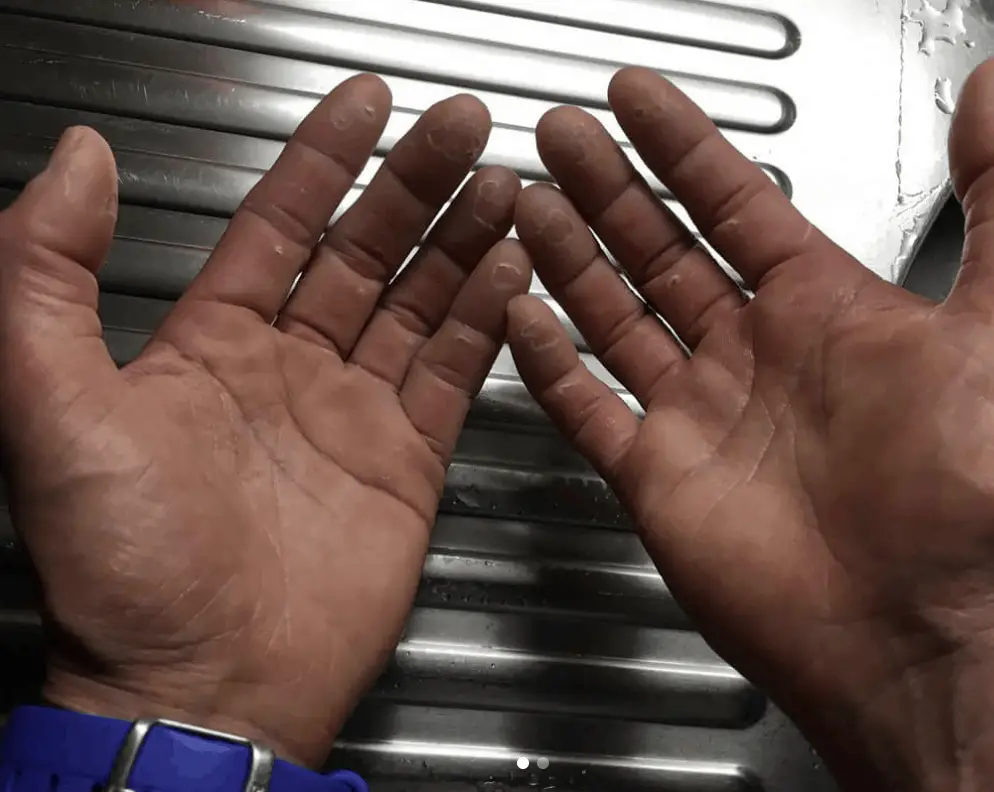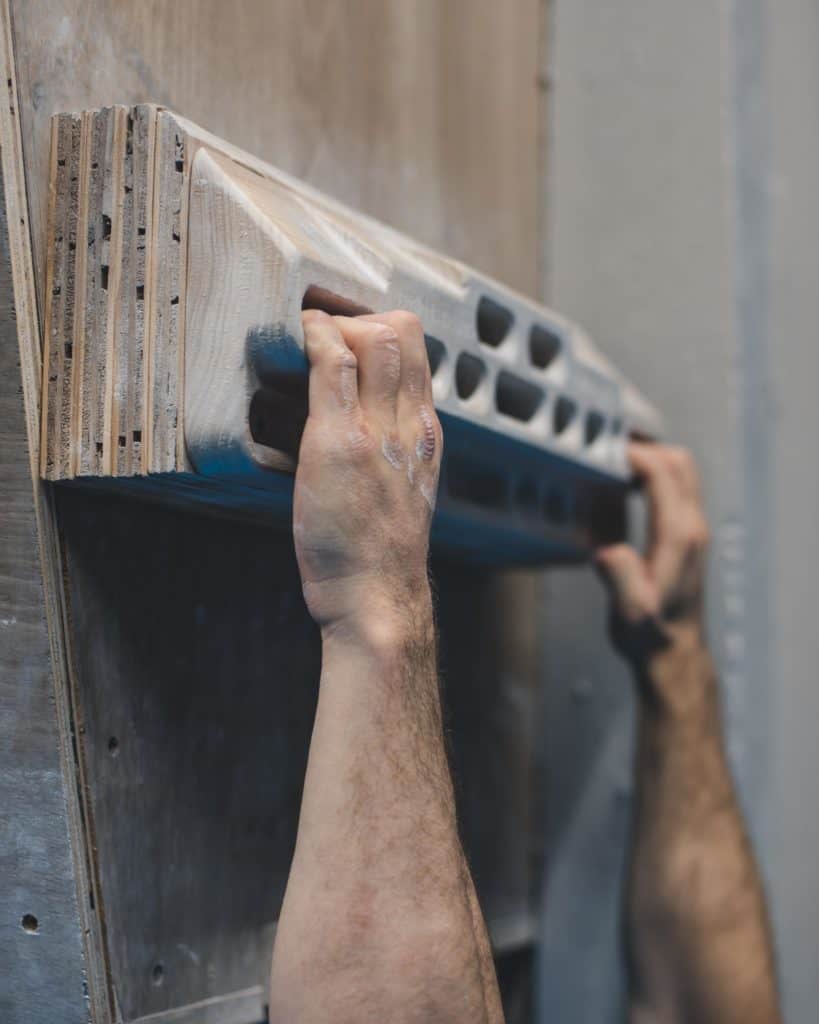
You may be worried about whether rock climbing will change the way your fingers look. Seeing veteran climbers with fat fingers might have you thinking twice about whether to take up the sport. In this article, we will give you a rundown of what scientific research has to say about it and also what you can do to protect your fingers while climbing.
So, does rock climbing make your fingers fat? The reason rock climbers do sometimes have thicker-looking fingers is tied to both how often and how hard they train. Supporting so much weight on the fingers causes the tendons to grow, sometimes doubling in size. The bones also can thicken to help protect the digit from stress damage like microfractures.
Page Jumps
- Scientific Studies That Explain Why Climbers Have Fat Fingers
- Will You Get Fat Fingers if You Start Climbing?
- Related Injuries to Fingers from Rock Climbing
- Finger Injury Management for Rock Climbing
- How to Strengthen Fingers for Rock Climbing
- Conclusion
Scientific Studies That Explain Why Climbers Have Fat Fingers
The Department of Trauma and Orthopedic Surgery in Germany did a study on young adult rock climbers (14-16 years old) to determine if their finger bones would change the longer they climbed. What they found was that young adults were less likely to listen to medical advice about restraint in terms of how often and how hard they trained, so they were more likely to exhibit physical damage in terms of injury. This sometimes led to permanent disfiguration due to an increase in bone deposit in the area being overstressed. Their ultimate conclusion was that “Climbers aged <16 years should not undertake intensive finger strength training and cannot participate in international bouldering competitions.”
A 2006 study by the FBI Laboratory, Trace Evidence Unit at Quantico “suggests that the intensity of stress encountered is more important than the frequency of stress” when it comes to physical changes in fingers. The same study concluded that “the relationship between measures of bone thickness and sport climbing and bouldering, and not traditional climbing or years of climbing, indicate that bone remodels to accommodate high-intensity mechanical stress and not too frequent low-intensity stresses, even if maintained over long periods of time.” This points to overworking fingers during climbing as the main contributor to increased bone deposits and tendon growth.
Unsurprisingly, repeated injury or overstressing the middle fingers will lead to bone spurs, which cause a thickening of the digit. This is not seen in every climber. In a study by the Rheumatism and Rehabilitation Research Unit at the University Department of Clinical Medicine in the UK, they looked at x-rays of 36 climbers, and less than half exhibited larger digits or signs of bone deposits on the middle fingers. This indicates that the sport itself does not inherently cause your fingers to become bigger if you follow practical safety tips and medical advice.
Will You Get Fat Fingers if You Start Climbing?
As previously mentioned, this will depend greatly on how much you climb and whether or not you are overdoing it. When in doubt, consult a medical professional to determine how much stress you should be placing on your fingers to reduce the risk of thickening digits. It is not automatically going to happen if you start rock climbing. Low-stress, brief climbs do not contribute to thickening fingers.
Related Injuries to Fingers from Rock Climbing
Most injuries take place on the ring finger, and this is caused by unequal weight distribution. The best way to protect your middle finger joints from injury is to work on finding positions and postures that allow for a better diffusion of weight between all the fingers. That way, no one digit will be experiencing too much stress. Source.
A commonly reported injury is tendinitis or tenosynovitis, which are caused by overuse of a tendon. This has been noticed in approximately 1 out of 4 top-level free climbers. The research supporting this can be found in this study. This can be a very painful condition and can be avoided by using proper hand posture when climbing and by not overstressing your body.
The Movement and Perception Laboratory at the University of the Mediterranean in France released a study on pulley injuries. Another injury often seen in competitive rock climbers is this pulley injury on the ring or middle finger. Source. The finger pulley system (e.g., Flexor Pulley System) is used to anchor the flexor tendons to the finger bones. Too much-repeated stress on this system will cause it to fail to lead to painful injuries of the pulley, tendon, or bone. A way to keep this from happening is to spread out the weight distribution better between all the fingers.
Finger Injury Management for Rock Climbing
If you are mid-climb and suffer an injury to your finger pulley system, then do not try to climb through the pain in that finger. You may hear or feel a snap, and it will be very painful to flex because one or more of the anchor pulleys has been torn away from the tendon and bone. The best way to treat it is to stop climbing immediately and rest the finger. You should not do anything that requires bending it so that it will be able to heal without further damage. Any injury should be seen by a medical professional.
If you experience painful and swollen joints, then that means you have most likely inflamed the tendons from climbing above your level or climbing too much in a short period of time. Overstressing your joints will make them inflame, and they will not heal until you give them some time to rest. Once the swelling goes down, do not go straight back into hard routines, take it slow, and build up your hand’s strength.
Another cause of swollen and aching joints is a stress fracture or build-up of micro-fractures in the bone. This cause and treatment are the same as those for tendinitis or tenosynovitis. Stress fractures can take much longer to heal, however, so you may need to stop climbing for 1 to 3 months. If you try to jump back into it before your bone is fully healed, you will reinjure it and possibly cause even more damage.
In addition to rest, hot and cold water treatment is another thing you can do to get blood flow to the area and help encourage faster healing. The steps are pretty simple. You put the finger in cold water for several minutes and then immediately place it in warm water for several minutes. Repeat 3 to 5 times. You should wait to use this until the area is no longer inflamed or swollen.
How to Strengthen Fingers for Rock Climbing
There are a few things you can do to strengthen your fingers so that they are less likely to sustain an injury.
Using a hangboard

This is one of the most reliable ways to strengthen your fingers. You can use it three or four times a week, but make sure you take rests on days in between. There are plenty of different kinds of hangboards, and you can mount it anywhere that can hold your weight, so they are easy to set up and use. Make sure that it is situated so that you can easily lower yourself to the floor after a deadlift. Dropping to the floor can potentially injure your fingers. Beginners shouldn’t use a hangboard until they’ve been climbing for at least 6 months. I’ve does extensive research and had countless experiences on different hangboards; you can check out my recommended hangboards at this link.
Forearm exercises
You can use a dumbbell by starting with picking the weight up on your fingers and then rolling it up into a fist. If you can comfortably do this ten times, then the weight is too light. You should be able to do approximately eight before needing a rest.
Forearm curls are kind of a mirror of the previous exercise. You start with the weight in your closed fist and then slowly release it and move it down to your fingers and then bring it back up into a closed fist. Again, if you can do this comfortably for ten rounds, then you will need a higher weight.
Climbing more often
Frequent, low-intensity climbs will not only build up your strength but will also keep your fingers from protecting themselves by growing thicker tendons and bones. Steady, often climbing with minimal stress on your finger joints, is best. You can keep climbs low-intensity by balancing out the weight onto all your fingers and keeping to easier climbs.
Conclusion
There are plenty of ways you can work to keep your fingers in top shape and looking great. Keep your workouts low stress and listen to your body. Make sure that if you are doing extra workouts for arm or finger strength, that you take plenty of rests in between. If you are in pain, then something is wrong, and you should readjust your level of climbing and allow your hands to rest. You can go enjoy a healthy workout at your local rock wall now that you know how to protect your fingers and deal with any common injuries.
